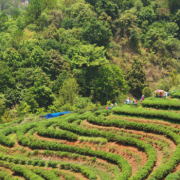New ATTRA Publications, Videos Showcase Urban Agroforestry
Agroforestry integrates agriculture and forestry to get the most out of a single piece of land. The National Center for Appropriate Technology’s ATTRA Sustainable Agriculture program has released new resources that detail how by adding trees to crop and livestock operations, farmers and ranchers can “over-yield,” that is, produce multiple products from the same piece of land.
Agroforesty also benefits the farm and the greater ecosystem by creating wildlife habitat, sequestering carbon dioxide from the atmosphere, increasing beneficial insect populations, improving soil water-holding capacity, controlling soil erosion, reducing leaching and runoff, and improving soil fertility.
ATTRA has long been a trusted source for practical information about designing and maintaining agroforestry systems.
Four new publications and five videos make that connection even stronger by showcasing the use of agroforestry in urban settings and offering practical tools to growers who would like to begin urban agroforesty operations.
“Agroforestry practices can help ease issues that urban and suburban farmers often face,” says Katherine Favor, the NCAT Agriculture Specialist who penned the new publications. “Urban areas often face issues like water contamination from mismanaged stormwater runoff, heavy metal buildup in the soil, pollution, lack of privacy, and lack of habitat for wildlife, among others. Trees that are integrated properly into urban landscapes can address those problems and can produce food for families and communities.”
The new publications can be downloaded at no cost from the ATTRA website. Plus, learn even more about the benefits of agroforestry Tuesday, March 7 during NCAT’s annual conference, Growing Hope: Practical Tools for Our Changing Climate.
- Urban Agroforestry Tipsheet: Food Forests and Beyond
Urban agroforestry, sometimes called community agroforestry, is the intentional integration of perennial trees and shrubs into farms and communities in urban and suburban areas to provide benefits to the community and to improve sustainability and resilience. - Urban Agroforestry Case Study: A Food Forest on Public Park Land
The Festival Beach Food Forest is located on three-quarters of an acre of public park land in Austin, Texas. Open day and night to the public, it provides a source of food for the community to forage and a place to connect with nature and each other. - Urban Agroforestry Case Study: Utilizing Agroforestry in Floodplain Restoration Projects
To prevent the loss of property and life, the City of Austin decided to purchase homes in dangerous floodplain areas, relocate residents to safer areas, and restore the floodplain buyout area in an ecological way.
Urban Agroforesty Tipsheet Food Forests and Beyond also is available in a Spanish translation.
- Hoja de Datos La Agroforestería Urbana: Bosques Comestibles y Más
La agroforestería urbana, a veces llamada agroforestería comunitaria, es la integración intencional de árboles y arbustos perennes en granjas y comunidades en áreas urbanas y suburbanas, para proporcionar beneficios a la comunidad y mejorar la sostenibilidad y la resiliencia.
Agroforestry videos also are available on the ATTRA website.
- Multiple Levels of a South Texas Food Forest
In this video, we take you on a tour of the food forest at Keepers of the Garden, an urban agroforestry farm in Corpus Christi, Texas. This urban agroforestry farm is located in the Southern Subhumid Gulf Coastal Prairies ecoregion, in hardiness zone 9b, and it serves not only as a production farm, but also as an educational center for schools, a refuge for local wildlife, and a community hub. - Managing and Maintaining a Coffee System in California
In this video, organic farmer Scott Murray discusses how to manage and maintain a coffee system in warm areas such as Southern California. Scott talks about pruning, pest management, harvest, quality control, processing, marketing, selecting varieties for Southern California, and interplanting with trees to create a beneficial microclimate. - Managing Water and Nutrients in a Coffee and Avocado Alley Cropping System
In this video, we head to Jason Mraz’s family farm in San Diego, California, where he is growing both specialty coffee and avocados in a single integrated alley cropping system. This video explores the specifics of the below-ground considerations to think about when managing a coffee and avocado alley cropping system, including how to meet both crops’ water and nutrient needs. - Designing a Coffee and Alley Cropping System
This video case study takes us on a tour of Jason Mraz’s family farm in San Diego, California, where he is growing both specialty coffee and avocados in a single integrated alley cropping system. - Planning and Establishing a Coffee System in Southern California
In this video, organic farmer Scott Murray discusses everything you need to know about how to plan and establish a coffee plantation in warm areas like Southern California. Scott discusses growing coffee seedlings in the nursery, transplanting, hardening off, and interplanting with trees to create a beneficial microclimate.
ATTRA Sustainable Agriculture Specialist Katherine Favor also has shared her expertise on agroforestry in several recent ATTRA blogs posts. ATTRA’s agroforestry resources can plant the seed of new ideas for new products and ecosystem benefits on your operation. Check them out, along with ATTRA’s other trusted and practical resources at attra.ncat.org/topics/agroforestry/.



